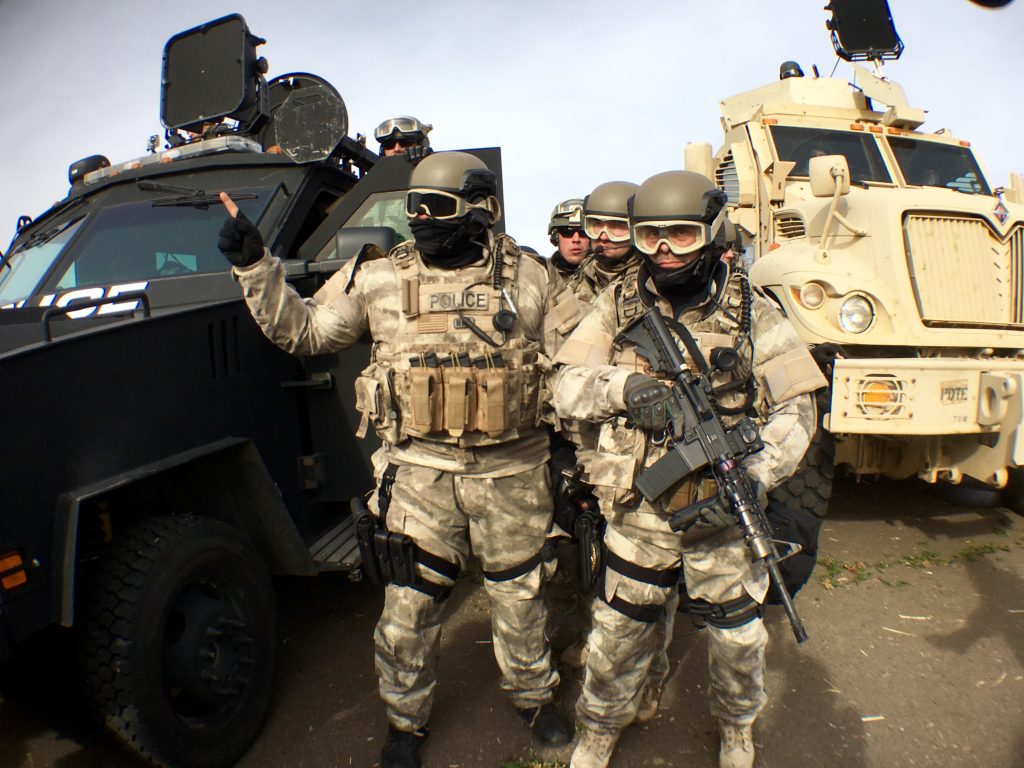
There was an interesting discussion that emerged yesterday on the need for the Sheriff’s Office to have an MRAP (Mine Resistant Ambush Protected vehicle). One poster noted the quick rise of AntiFa (short for Anti-Fascist) which has emerged in some ways as a radical left counterpart to the Alt-Right.
The poster argued, “The MRAP is an example of the tools law enforcement may need to deal with this organization if it continues to spread.”
But is that really a good idea even if it might be a helpful tool? The poster quickly noted, “I personally hope it just sits in the police lot and collects dust.” But the track record for such “tools” has been that if they are available, they get used.
More importantly, rather than help to de-escalate tensions, their use has proven to escalate problems and even incite violence.
On August 15, 2014, the St. Louis Post-Dispatch ran the story where they reported, “The focus on continuing protests here turned Thursday toward paramilitary tactics and equipment that critics — even among some law enforcement leaders — say have provoked violence from the crowds.”
Tim Lynch, director of the Cato Institute Project on Criminal Justice, said police use of military weapons and tactics accelerated after the 2001 terrorist attacks, in part because of Homeland Security grants.
The availability of such equipment, he said, is blurring the line of “the civilian police mission with the military mission and when that happens, there are unnecessary, violent confrontations between the police and citizens such as we’re seeing in Ferguson.”
He continued, “It’s only when there has been some kind of horrible tragedy, like somebody getting shot or somebody getting killed during one of these paramilitary raids … that the hard questions start getting asked — the questions that should have been asked since the beginning.”
In Standing Rock, likewise, the use of federally-supplied military equipment was criticized heavily, with criticism of abusive police practices.
In October, the New York Times reported, “The authorities arrived at the pipeline protest on Friday in military-style vehicles and demanded that the protesters vacate the camp.”
Rather than quell the situation, that led to an escalation with the use of bean bags, rubber bullets, pepper spray and ultimately water fired in subfreezing temperatures from water cannons on the protesters.
The Indian Country Media Network reported, “On Thursday October 27, police executed a particularly violent sweep of a camp that left structures destroyed, more than 140 people arrested, cars impounded and others burning on the side of the road. The highly militarized response—armored vehicles and heavy weaponry—was recorded by many people caught in the assault.”
But here is the important point – in neither case did the use of military vehicles help to quell the situation. In both cases, it ended up escalating an already volatile situation.
In the discussion one of the posters noted, “I certainly agree that having the MRAP appear at an otherwise peaceful protest would be nuts.”
But what they seem to fail to understand is that bringing the MRAP to even a situation like a Milo Yiannopoulos protest would have backfired on authorities.
As chaotic as the scene was on campus that Friday night where the situation was deemed unsafe, the university managed to avoid the use of mass arrests to get the situation under control. Can you imagine what would have happened had the university brought out an MRAP?
I can only imagine how much my phone would have blown up. Social media would have gone crazy. Instead of 1000 people out there, there quickly would have been 5000, maybe 10,000. The situation would have gone from chaos to grave.
Whatever concerns you might have with a relatively small in number but destructive group like AntiFa, rolling out an MRAP would escalate the situation by five to tenfold almost instantly, given the speed of Facebook, Twitter and text messages.
In neither the Ferguson or Standing Rock situations did the use of police military vehicles prove useful. In fact, history shows that they did just what we would expect – they escalated the situation. The New York Times reported about the first arrival of military-style vehicles in October – and we know both November and December were more, not less, contentious situations.
As we saw in the spring of 2015, there are times when some sort of armored vehicle is helpful. As it turned out, there was not an active shooter/hostage situation in West Davis, as the individual had already killed himself by the time police arrived, but my concern is that the prevalence of these vehicles leads to mission creep.
We already have an MRAP in both Woodland and West Sacramento, and both of those managed to find their way to Davis in March 2015. I would argue against those vehicles as well, but their presence makes it all the harder to convince me we need one in the hands of the Yolo County Sheriff’s Office as well.
—David M. Greenwald reporting






Prieto says he will not use the MRAP against protesters
But polices can change, and MRAPs may be around longer than those who deploy them. We can’t rely on the assurances of one individual.
Your argument was raised during public comment and I think an extremely pertinent one especially considering Prieto is 74 and close to retirement.
Good, I’m glad to hear that. Wish I could have been there, but classes were calling.
David:
An “honest” question for you.
Regardless of vehicles like the MRAP, what do you think is the best way to deal with violent protestors, overall? (Those willing to engage in physical violence toward others, repeated instances of vandalism, etc.) And, on a lesser level, repeated shut-downs of major roadways/freeways? (In addition to inconvenience/impacts for everyone, it’s dangerous, as well. The act of shutting it down is dangerous, as well as blocking emergency vehicles from getting through. Such actions may even create the “need” for emergency vehicle access.)
And since when is “violent protestors” a common problem vexing our everyday lives in Yolo County? And the point is, what would you do with an MRAP? Machine gun the protestors?
Ron
I am not speaking for David, but I think that then officer Pytel during the UCD pepper spray incident is a model to address your question. There are clips of officer Pytel, at nearly the same time as Sgt.Pike was pepper spraying seated students, walking through a crowd of protestors and onlookers, talking with them and gently moving them aside. It was the campus police, arriving in riot gear that caused the escalation that they then escalated. I believe it is most often the case ( and certainly has been here) that protesters can be either reasoned with, or waited out, both of which I find preferable to police induced violence.
Usually violence in protests escalates from a clash. From that perspective, keeping proper spacing between conflicting sides can usually keep our level of violence to a minimum. When people blocked the bay bridge, the police barricaded it off to keep people safe, people had their moment of protest, people were inconvenienced, and the world move on.
David:
Agreed, to a point. But, it seems to keep happening. Not a “one time” occurrence. (Not just blocking traffic – which is inherently dangerous, but vandalism and violence, as well. Seems like the police are already keeping a “safe distance”, in some of those situations.)
Also – what about truly violent protests (e.g., those violently opposed to Milo, white supremacist groups, etc.)? How should that be handled? Same thing with some of the violent protests regarding police actions. (Not sure that there is a good answer, regarding that.)
I would suggest reading this – this is from PERF –
http://www.policeforum.org/assets/docs/Critical_Issues_Series/managing%20major%20events%20-%20best%20practices%20from%20the%20field%202011.pdf
There is…
Intergalactic military: Starfleet, Jedi and others (science fiction; space fantasy);
United Earth military: United Nations (coalition of national military forces), Babylon 5 and others (science fiction; space fantasy);
Global North military: NATO (coalition of national military forces);
National military operating formally or mostly outside of its country: CIA, MI6, Mossad and others;
National military: Armed forces of the U.S.A., etc;
National military forces operating within national borders, generally relatively lightly armed and with specialized tasks: U.S. Federal Marshalls, U.S. FBI, and forces responsible for all internal interests of the national government in most countries aside from the USA;
No national military: Costa Rica, Iceland, Panama, Micronesia, Marshall Islands, Vatican and about 17 others;
Not quite official military/multiple military forces within one nation: Hezbollah, Hamas, Preventive Security Forces (Palestinian Authority), and others;
Territorial military: RCMP, United Kingdom;
State military: California National Guard and others in the USA;
County military: Sheriffs operating mostly in unincorporated areas in the USA
Municipal military: NYPD, Davis Police Department and others;
City district level military: City Police in Prague and other Czech cities and others.
The “police” are already militarized. All “police” are military. They are armed employees of government bodies. (There are partial exceptions such as “Bobbies” in the UK, forming part of their territorial forces who do not carry firearms themselves but with firearm-equipped services on call.) They have widely different tasks, levels of trust and of corruption, and so on. Yet there is no essential difference amongst all of them: Their mission is protect the interests of one or more political entities – and to varying degrees certain individuals and public and private companies partnering with those bodies. To wildly varying degrees and with wildly varying strategies and tactics these forces sometimes attempt to protect formally-unarmed citizens from each other (and their property). These conditions are further influenced by the level of democracy and the power and organization of normal, non-formally-militarized citizens within various political boundaries.
It is a certainly a good thing to have nuclear arms treaties, bans on certain types of weapons, “less lethal” tactics training and so on… but the essential nature of military forces is the same both in reality (and too many speculative realities.)
The vote was 2-1-2 to prolong the agony (because they couldn’t get three votes) on April 25.
Saylor and Rexroad voted to kill it
Villegas voted against killing it
Provenza and Chamberlain abstained
Then Villegas, Provenza and Chamberlain voted 3-2 to bring it back on April 25
I would be concerned with providing such a large and expensive piece of equipment to the Yolo County Sheriff’s office because of their lack of transparency. When the “bacon-bomber” case at the Islamic Center broke with an arrest, the Sheriff’s office did not release the booking photo of the suspect. Now, I actually don’t care that much about her picture but I was intrigued when the press made note of it. I emailed the Sheriff’s office and asked why that was the case. The answer I got was “It is the long standing practice of the Yolo County Sheriff’s Office not to release the booking photographs of individuals brought in to our jail. Periodically, the Sheriff makes exceptions to this rule. This is done at his discretion.” So, apparently the Sheriff does whatever he feels like and has no written policy governing something as simple as the release of a booking photo. I can only imagine how that translates to the use of the MRAP. Provenza, what are you thinking out there?